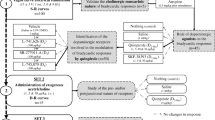Summary
The antimuscarinic effects of methoctramine (N, N′- bis[6-[(2-methoxybenzyl)amino]hexyl]-1,8-octanediamine tetrahydrochloride), a polymethylene tetraamine endowed with high cardioselectivity in vitro, were assessed in two in vivo preparations. Methoctramine (300 μg/kg i.v.) strongly inhibited the methacholine- and muscarine-induced bradycardia in the anaesthetized and pithed rat, respectively. The same dose of methoctramine did not significantly affect the depressor action of methacholine in the anaesthetized rat mediated by vascular M2 receptors. Furthermore, even high doses of methoctramine (up to 1 mg/kg i. v.) did not reduce the ganglionic M1 receptor-mediated tachycardia and pressor response to muscarine or McN-A-343 in the pithed rat. These data suggest that methoctramine while showing high affinity for cardiac M2α receptors has rather low affinity for ganglionic M1 and vascular M2 receptors. This in vivo study thus provides further evidence to support the view that methoctramine is a potent and highly selective antagonist of cardiac M2α receptors.
Similar content being viewed by others
References
Barlow RB, Berry KJ, Glenton PAM, Nikolaou NM, Soh KS (1976) A comparison of affinity constants for muscarine-sensitive acetylcholine receptors in guinea-pig atrial pacemaker cells at 29°C and in ileum at 29°C and 37°C. Br J Pharmacol 58:613–620
Barlow RB, Shepherd MK (1985) A search for selective antagonists at M2 muscarinic receptors. Br J Pharmacol 85:427–435
Birdsall NJM, Curtis CAM, Eveleigh P, Hulme EC, Pedder EK, Poyner D, Stockton JM, Wheatley M (1987) Muscarinic receptor subclasses. In: Dowdall MJ, Hawthorne JN (eds) Cellular and molecular basis of cholinergic function. Ellis Horwood Ltd, Chichester (England), pp 46–55
Choo LK, Malta E, Mitchelson F (1986) The affinity of some selective muscarinic receptor antagonists for the muscarinic receptor mediating endothelial-dependent relaxation of the rabbit and rat thoracic aorta. J Pharm Pharmacol 38:843–845
Doods HN, Mathy M-J, Davidesko D, van Charldorp KJ, de Jonge A, van Zwieten PA (1987) Selectivity of muscarinic antagonists in radioligand and in vivo experiments for the putative M1, M2 and M3 receptors. J Pharmacol Exp Ther 242:257–262
Duckles SP, Yamamura HI, Lee V (1987) AF-DX 116 discriminates between muscarinic M2 receptors of the heart and vasculature. Life Sci 40:1507–1511
Giachetti A, Micheletti R, Montagna E (1986) Cardioselective profile of AF-DX 116, a muscarine M2 receptor antagonist. Life Sci 38:1663–1672
Giachetti A, Giraldo E, Melchiorre C, Micheletti R, Ladinsky H (1988) Further characterization of methoctramine interaction with muscarinic receptors. Trends Pharmacol Sci 9 [Suppl]: Abstr No 40
Gilani ASH, Cobbin LB (1986) The cardio-selectivity of himbacine: a muscarine receptor antagonist. Naunyn-Schmiedeberg's Arch Pharmacol 332:16–20
Hammer R, Giachetti A (1982) Muscarinic receptor subtypes: M1 and M2. Biochemical and functional characterization. Life Sci 31:2991–2998
Hammer R, Giraldo E, Schiavi GB, Monferini E, Ladinsky H (1986) Binding profile of a novel cardioselective muscarine receptor antagonist, AF-DX 116, to membranes of peripheral tissues and brain in the rat. Life Sci 38:1653–1662
Hynes MR, Banner W, Yamamura HI, Duckles SP (1986) Characterization of muscarinic receptors of the rabbit ear artery smooth muscle and endothelium. J Pharmacol Exp Ther 238:100–105
Lambrecht G, Moser U, Mutschler E, Wess J, Linoh H, Strecker M, Tacke R (1984) Hexahydro-sila-difenidol: a selective antagonist on ileal muscarinic receptors. Naunyn-Schmiedeberg's Arch Pharmacol 325:Suppl R62
Lambrecht G, Mutschler E (1985) Selective inhibition of muscarinic receptors in intestinal smooth muscle. In: Lux G, Daniel EE (eds) Muscarinic receptor subtypes in the GI tract. Springer, Berlin Heidelberg New York, pp 20–27
Lambrecht G, Mutschler E, Moser U, Riotte J, Wagner M, Wess J, Gmelin G, Tacke R, Zilch H (1987) Heterogeneity in muscarinic receptors: Evidence from pharmacological and electrophysiological studies with selective antagonists. In: Cohen S, Sokolovsky M (eds) International symposium on muscarinic cholinergic mechanisms. Freund Publishing House Ltd, London, pp 245–253
Melchiorre C, Cassinelli A, Quaglia W (1987a) Differential blockade of muscarinic receptor subtypes by polymethylene tetraamines. Novel class of selective antagonists of cardiac M-2 muscarinic receptors. J Med Chem 30:201–204
Melchiorre C, Angeli P, Lambrecht G, Mutschler E, Picchio MT, Wess J (1987b) Antimuscarinic action of methoctramine, a new cardioselective M-2 muscarinic receptor antagonist, alone and in combination with atropine and gallamine. Eur J Pharmacol 144:117–124
Michel AD, Whiting RL (1988) Methoctramine, a polymethylene tetraamine, differentiates three subtypes of muscarinic receptor in direct binding studies. Eur J Pharmacol 145:61–66
Micheletti R, Montagna E, Giachetti A (1987) AF-DX 116, a cardioselective muscarinic antagonist. J Pharmacol Exp Ther 241:628–634
Mutschler E, Gmelin G, Moser U, Wess J, Lambrecht G (1987) Structure-activity relationships of drugs acting selectively at different muscarinic receptors. In: Rand MJ, Raper C (eds) Pharmacology. International Congress Series No. 750, Excerpta Medica (Elsevier), Amsterdam, pp 67–75
Van Charldorp KJ, de Jonge A, Thoolen MJMC, van Zwieten PA (1985) Subclassification of muscarinic receptors in the heart, urinary bladder and sympathetic ganglia in the pithed rat. Naunyn-Schmiedeberg's Arch Pharmacol 331:301–306
Vatner SF (1978) Effects of anesthesia on cardiovascular control mechanisms. Environ Health Perspect 26:193–196
Waelbroeck M, Camus J, Winand J, Christophe J (1987) Different antagonist binding properties of rat pancreatic and cardiac muscarinic receptors. Life Sci 41:2235–2240
Wess J, Lambrecht G, Moser U, Mutschler E (1984) A comparison of the antimuscarinic effects of pirenzepine and N-methylatropine on ganglionic and vascular muscarinic receptors in the rat. Life Sci 35:553–560
Wess J, Lambrecht G, Moser U, Mutschler E (1987a) Stimulation of ganglionic muscarinic M1 receptors by a series of tertiary arecaidine and isoareaidine esters in the pithed rat. Eur J Pharmacol 134:61–67
Wess J, Lambrecht G, Mutschler E, Melchiorre C, Angeli P (1987b) Selective blockade in vivo of cardiac muscarinic M2 receptors by a polymethylene tetramine, BHC-9C. Eur J Pharmacol 142:475–478
Author information
Authors and Affiliations
Additional information
Send offprint requests to: G. Lambrecht at the above address
Rights and permissions
About this article
Cite this article
Wess, J., Angel, P., Melchiorre, C. et al. Methoctramine selectively blocks cardiac muscarinic M2 receptors in vivo. Naunyn-Schmiedeberg's Arch Pharmacol 338, 246–249 (1988). https://doi.org/10.1007/BF00173395
Received:
Accepted:
Issue Date:
DOI: https://doi.org/10.1007/BF00173395




